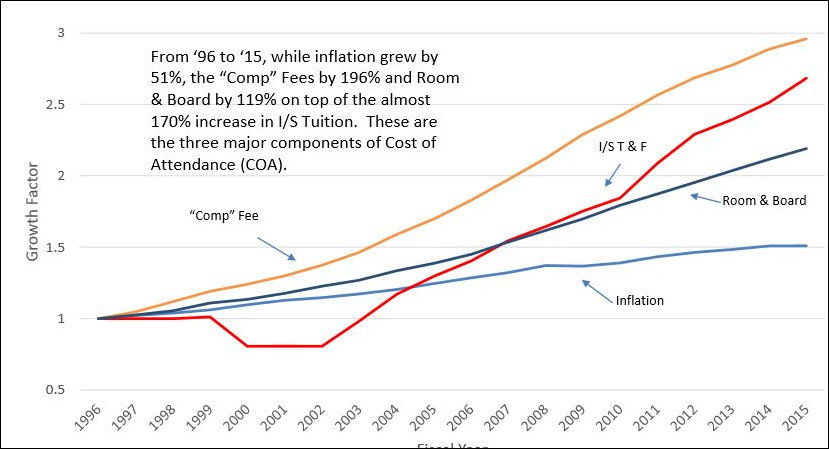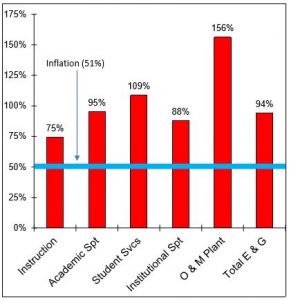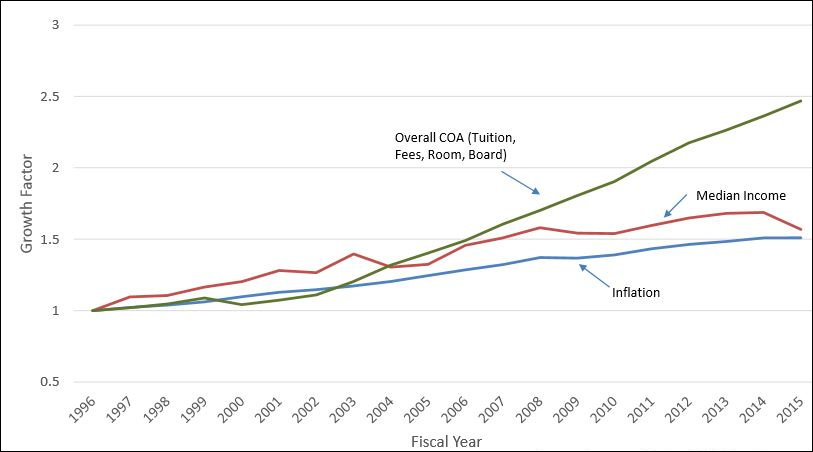
Affordability components at public 4-year institutions. Source: Tony Maggio. Note: I/S = in-state. T&F = tuition & fees.
Half the increase in tuition over the past 20 years at public Virginia four-year colleges and universities can be attributed to a drop in state support for higher education. But tuition accounts for only 28% of the total cost of attendance in Virginia, according to a presentation that Anthony A. “Tony” Maggio, a legislative fiscal analyst, made to the House Appropriations Committee yesterday.
In other words, university policies, not state budget cuts, have been responsible for about 86% of the increase in the total cost of attending college in the Old Dominion today.
“Often you hear that it’s the General Fund reductions that have been the sole reason” for rising tuition, said Maggio, as quoted by the Richmond Times-Dispatch. But the cost of fees, room and board have dramatically outpaced inflation as well.
Maggio called for more transparency in how state dollars are spent. One big question: How much does undergraduate tuition subsidize student aid? How much does it subsidize graduate-level programs?
The soaring cost of attendance at Virginia’s public universities far outpaced inflation and median household incomes in the commonwealth, according to Maggio.

Percentage spending increase per student, by program, FY 1996 to FY 2015, at four-year institutions.
So, where is all that money going? The category that is seeing the smallest increase is the universities’ core mission of educating students. Instructional spending increased about 75%, faster than inflation, but slower than all other categories.
“Academic support” increased 95%. According to a Virginia Tech glossary of terms, that includes libraries, museums, A/V services, computing support, ancillary support, academic administration, personnel development, and course & curriculum development.
“Institutional support,” which saw an 88% increase, covers day-to-day operations of the university, such as executive management, fiscal operations, logistical services, public relations, development, and general administrative services.
(Student services,” which grew 109%, covers expenses for student activities whose purpose is the “emotional and physical well-being” of the students and their “intellectual, cultural and social development outside the context of formal instruction.” (I would be interested to know if this category includes the growing diversity and gender equity bureaucracies.)
The fastest-growing category is Operations & Maintenance of Plant, where spending grew 156%. What is hard to differentiate here is the extent to the surge in spending can be explained by the need to accommodating larger enrollment from a growing population, or by the Taj Mahal effect in which universities compete for students and faculties by building ever more impressive facilities. The $50 million renovation of the University of Virginia’s Rotunda comes to mind.
Bacon’s bottom line: The monstrous cost of college attendance is both a source of financial distress to middle-class families and a huge barrier to attendance the poor. The primary beneficiary is the higher education apparat, which engages in a never-ending chase for greater institutional prestige as measured by average student SAT scores, acceptance rates, recruitment of star faculty, the size of endowments, and other factors that have very little to do with actually educating students.



